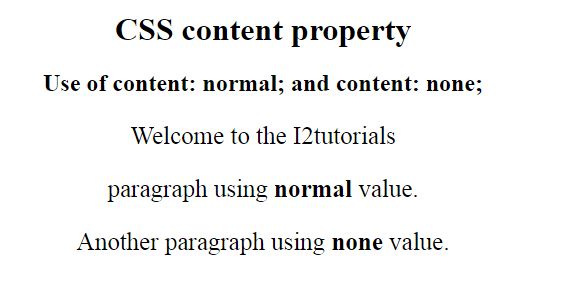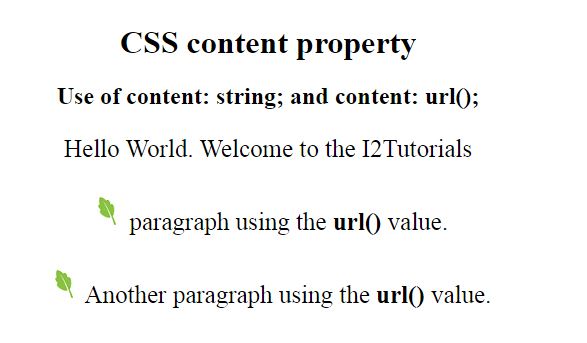CSS content property
CSS content property generates dynamic content. It can be used with the pseudo-elements ::before and ::after. CSS content property is fully supported in all web browsers and used to insert the generated content on a web page.
Syntax:
content: normal | none | counter | string | attr | open-quote | close-quote | no-close-quote | no-open-quote | url | initial | inherit;
Property Values:
- normal: Set the default value.
- none : Value does not set the content.
- counter : The content as a counter.
- string : Content to the text you specify.
- open-quote : Content to be an opening quote.
- close-quote : Content to be a closing quote.
- no-open-quote: Remove the opening quote from the content.
- no-close-quote: Remove the closing quote from the content.
- url(url) : Set the content to some media(image, video, audio, etc.).
- initial : property to its default value.
- inherit : property from its parent element.
Example :
Using normal and none value.
<!DOCTYPE html>
<html>
<head>
<title>
CSS content Property
</title>
<style>
body{
text-align: center;
}
p{
font-size: 25px;
}
p::before {
content: "Welcome ";
}
#para::before {
content: normal;
}
#para1::before {
content: none;
}
</style>
</head>
<body>
<h1> CSS content property </h1>
<h2> Use of content: normal; and content: none; </h2>
<p> to the I2tutorials </p>
<p id = "para"> paragraph using <b>normal</b> value. </p>
<p id = "para1"> Another paragraph using <b>none</b> value. </p>
</body>
</html>
OUTPUT:

Example –
Using string and url value
<!DOCTYPE html>
<html>
<head>
<title>
CSS content Property
</title>
<style>
body{
text-align: center;
}
p{
font-size: 25px;
}
p::before {
content: "Hello World. Welcome ";
}
#para::before {
content: url("img.png");
}
#para1::before {
content: url("img.png");
}
</style>
</head>
<body>
<h1> CSS content property </h1>
<h2> Use of content: string; and content: url(); </h2>
<p> to the I2Tutorials </p>
<p id = "para"> paragraph using the <b>url()</b> value. </p>
<p id = "para1"> Another paragraph using the <b>url()</b> value. </p>
</body>
</html>
OUTPUT:

Example –
Using open-quote and close-quote value.
<!DOCTYPE html>
<html>
<head>
<title>
CSS content Property
</title>
<style>
body{
text-align: center;
}
p{
font-size: 25px;
}
p::before {
content: open-quote;
}
p::after {
content: close-quote;
}
</style>
</head>
<body>
<h1> CSS content property </h1>
<h2> Use of content: open-quote; and content: close-quote; </h2>
<p> Welcome to the I2tutorials </p>
<p> Another paragraph. </p>
</body>
</html>
OUTPUT:

Example –
Using no-open-quote and no-close-quote value.
<!DOCTYPE html>
<html>
<head>
<style>
body{
text-align: center;
}
p{
font-size: 25px;
}
p::before {
content: open-quote;
}
p::after {
content: close-quote;
}
p.para::before {
content: no-open-quote;
}
p.para::after {
content: no-close-quote;
}
</style>
</head>
<body>
<h1> CSS content property </h1>
<h2> Use of content: no-open-quote; and content: no-close-quote; </h2>
<p> Welcome to the I2tutorials </p>
<p class="para"> Another paragraph </p>
</body>
</html>
OUTPUT:

Example –
Using attr().
<!DOCTYPE html>
<html>
<head>
<title>
CSS content Property
</title>
<style>
body{
text-align: center;
}
a::after {
content: attr(href);
}
</style>
</head>
<body>
<h1> CSS Content property </h1>
<h2> Link is displayed by using the <b>attr()</b> </h2>
<a href= https://www.i2tutorials.com/>Click here!
</a>
</body>
</html>
OUTPUT:

